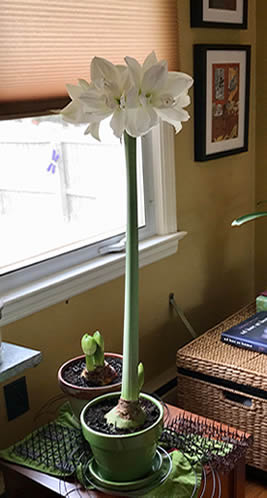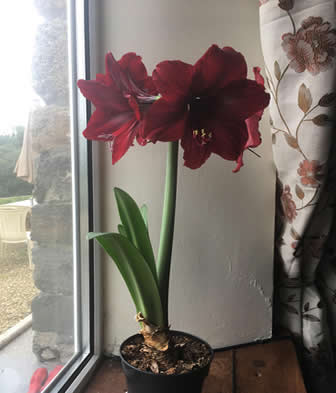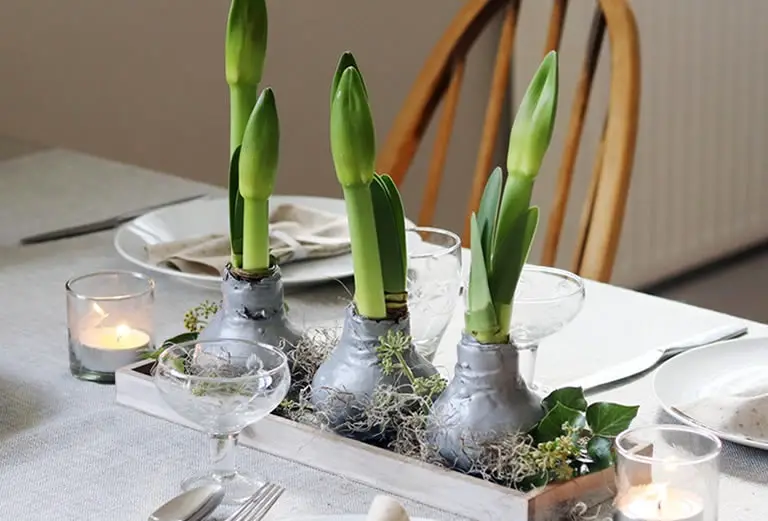In this article I will cover everything you need to know about the light needs of an amaryllis plant. As a succulent amaryllis has very specific light requirements and getting those requirements wrong can have negative effects on your plant.
Table of Contents
How much sun amaryllis really needs & the best type of sun
A common concern for many amaryllis growers is the type of light required for this succulent.
While some succulent species of plants love strong direct sunlight others prefer indirect light, and others even thrive in partial or full shade.

So how much sun does amaryllis need?
Amaryllis only needs 4 hours of sun to grow.
It can grow in direct sun, however too much strong direct sunlight will lead to leaf burn.
For this reason it is best to place your amaryllis in a location that gets at least 4 hours of good indirect light.
If you want your amaryllis plant to bloom then you need to ensure it gets at least 4 hours of light per day.
Amaryllis can sit all day in indirect light but always bear in mind that the plant will react poorly to prolonged periods of strong direct sunlight.
If you live in an area that gets lots of strong sun then you are better placing amaryllis in very well lit area that is away from direct sunlight.
A minimum of 4 hours of indirect light is best for amaryllis.
Of course being a succulent amaryllis is capable of growing in direct sunlight as long as the plant gets a certain amount of shade and protection from strong UV rays during the day.
Many people in Canada and the Northern US states can grow their amaryllis plants in full sunlight.
Those amaryllis owners who live in states that receive strong daily sunlight, like Nevada for example, should grow their plants in partial shade or in areas that receive only indirect light.
Amaryllis light requirements for indoor plants
As most amaryllis are grown as houseplants in the US I will address the light requirements of an indoor potted amaryllis plant.
If you intend to grow amaryllis outside, or want to move an indoor potted amaryllis outdoors, read my guide to using amaryllis outside.
So, when it comes to potted houseplants, how much light does an amaryllis need?
An amaryllis requires a minimum of 4 – 6 hours of light per day depending on its location.
If your Amaryllis is placed in an area that receives strong direct sunlight it can thrive on as little as 4 hours of direct sun per day.
However, too much direct sunlight may lead to leaf burn.
Amaryllis grown in an area with good indirect light can receive light for much longer periods and you should aim for a minimum of 6 hours of light per day.
Amaryllis is fairly hardy so it is difficult to get the positioning of the plant wrong as far as its light needs go.
You will only run into problems if you place your plant in an area they gets too much direct light or too little light in general, i.e. in full sun all day or in full shade or in an area that gets less than 4 hours of light.
Partial shade is fine for amaryllis as long as the plant receives at least 4 hours of good light per day.
The image below shows an Amaryllis Alfresco that is located beside a window that receives full sun for 8 -10 hours per day.
This would be too much for amaryllis.
So, by using simple window shades it was possible to limit that amount of direct light from hitting the plant thus protecting the plant from overexposure to string UV rays.
However, because there is still light entering through the window and fully illuminating the room the amaryllis plant still gets plenty of indirect light.

I advise amaryllis owners who place their plant in direct sunlight to ensure it gets only about 6 hours of sunlight per day.
Amaryllis are prone to leaf burn when left too long in strong direct sunlight.
Obviously this effect is worsened in areas of stronger sun and lessened in areas of weaker sun.
For example, an amaryllis plant left in 14 hours of direct sunlight per day in Las Vegas during the summer will not fare well. The same plant could grow happily if left in direct sunlight in Montana though.
If you are unsure about how many hours it is safe to leave your amaryllis in direct sun in your specific location simply move the plant to an area that receives only indirect light. Alternatively, move the plant away from direct sunlight after about 4 or 5 hours daily exposure.
What if you go too far and restrict too much light from reaching your amaryllis?
You will know that your amaryllis is getting insufficient light if the plant fails to bloom. Read my guide for treating non-blooming amaryllis here but be aware that immature amaryllis bulbs rarely bloom.
The bulb will have to mature for 3 years before you can expect to see the plant flowering so insufficient light is not always the cause of non-blooming plants.
Busting the myth of amaryllis needing full sun
Although amaryllis should not be left in strong direct sunlight for long periods, does this mean they do not need direct sun at all or does this succulent require at some … do amaryllis need full sun?
Amaryllis do not need full sun.
Although these succulents need plenty of light they can be kept out of direct sunlight in an area that gets plenty of good indirect light.
In fact, too much strong direct sunlight can cause leaf burn in amaryllis.
Amaryllis grow well in partial shade as long as they get at least 4 hours of good light per day.
I advise indoor amaryllis owners to avoid the potential problems that come from placing this type of succulent in full sun.
However, amaryllis still need plenty of light.
The main symptom of insufficient sun is a lack of blooms.
It is much easier to get an amaryllis to rebloom again when it has failed to bloom (due to insufficient light) than it is to treat leaf problems such as leaf burn (due to too much strong direct sunlight).
For this reason you should err on the side of caution when picking a location for amaryllis.

Aim to place your amaryllis in a location that gets plenty of good indirect light.
When you place amaryllis in an area that gets only indirect light then you do not have to worry about the plant getting too much light.
Amaryllis can grow easily in 16 hours of summer daylight as long as the light it receives is indirect light and not strong direct sunlight.
As I mentioned previously long periods of exposure to direct sunlight is likely to lead to leaf burn (you can read more about that in our amaryllis leaf care guide).
Partial shade is fine for amaryllis as long as the plant receives a minimum of 4 hours of good light per day.
Personally, I aim for 6 hours of good indirect light per day for indoor amaryllis as I find the blooms are much healthier and more vibrant.
If your plant is situated in a location that is dark or gloomy then you can use a grow light to provide extra lighting when needed.
Amaryllis bulb – light requirements when there is no foliage
What about the light need for an amaryllis bulb? What are the light requirements for an amaryllis bulb before it has entered a new growth stage and what are its light requirements when it enters a phase of dormancy.
An amaryllis bulb that is entering a new growth stage requires at least 4 hours of light per day.
6+ hours of indirect light is best for an indoor potted amaryllis though the more light it gets the better.
An amaryllis bulb that is entering its dormancy phase requires no light at all.
Although the bulb can be left in its original location I move mine to move to a dark storage area for 2 – 3 months to prevent premature growth spurts which can damage the bulb.
As I pointed out in the growth stages of amaryllis this succulent enters a phase of dormancy every year, where the bulb rests and gathers much-needed resources for its next growth cycle.
Amaryllis bulbs will happily go dormant sitting in the same pot, and in the same location, where they bloomed.
Though, most amaryllis owners, myself included, will move the bulb to a dark area of their home that gets limited light and allow it to rest for a few months.

And although it is not completely necessary to remove the bulb from its pot you can, like me, remove the bulb from the soil (which you will need to replace with fresh soil in the growing season anyway) and place it on some kitchen towels before moving into the chosen dark area of your home.
This makes storage easier and gives the bulb a little bit of added protection against premature growth.
Once the bulb shows signs of new growth you will know that it has left dormancy and is entering a new growth cycle.
At this point the bulb must be repotted in fresh soil and given access to at least 4 hours of light per day – though the more indirect light it gets the better it will grow.
You may want to read the article what to do with amaryllis bulbs after they bloom as this gives detailed instructions for storing an amaryllis bulb when it enters its dormant phase and also detailed instructions for how to get the plant thriving once it enters a new growth cycle.

